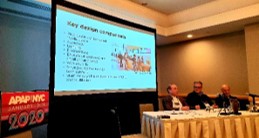How to Use Acoustics, Design & Staffing to Increase Community Engagement
AD’s own David Kahn was pleased to lead the professional development session “How to Use Acoustics, Design & Staffing to Increase Community Engagement” at the 2020 APAP conference held in New York on January 11th. In addition to David, who serves as President of Acoustic Distinctions, the panelists included Joshua Dachs, Principal at theatre consultancy Fisher Dachs Associates, and Steve Carignan Executive Director at the Gallagher-Bluedorn Performing Arts Center and Associate Dean for Outreach and Special Programs at the University of Northern Iowa (UNI) School of Music. We thank the Association of Performing Arts Professionals (APAP) for the opportunity to present a program that led to a stimulating and informative exchange of ideas.

Understanding community engagement
The session started with the panelists defining community engagement in the context of one’s experience in a performance space. They engaged the session participants with an exploration of why people attend performances. David discussed “the triangle of communication” (a paradigm for expressing the interaction between and among performers and audience members in a performance space) and discussed both the visual and audible aspects of the triangle of communication. He showed examples of various performance spaces to demonstrate how different facilities embody different visual and audible “triangles of communication.”

Joshua provided historical background illustrating how the evolution of performance spaces—from Greek amphitheaters to 20th-century concert halls— structure the engagement between people in different ways and represent changing ideas about the optimal conditions for creating powerful experiences.
The one truth that does not change through time is that performance spaces help build a shared experience, and their key design components—acoustics, lighting, environment, public space, a balance of openness and small group spaces, customer service, etc.—can be tailored to meet the expectations of the existing community.
GBPAC’s successful design
David, Joshua, and Steve discussed how their areas of expertise came together in the design of the Gallagher Bluedorn Performing Arts Center (GBPAC) at the University of Northern Iowa, which is celebrating its 20th anniversary in 2020 with plans for expansion. GBPAC is an embodiment of Joshua and David’s knowledge of how to create an audibly and visually engaging experience, as well as Steve’s vision of a community-based space that runs in the black. This is all the more remarkable for the fact that the original construction project was underbudgeted (the total project budget was just $23M), and some difficult decisions had to be made. David and Joshua’s emphasis on maintaining acoustic and visual quality in the performance space as the highest priority resulted in GBPAC receiving tremendous community support from day one. That well-earned community support is what will now allow the facility to expand, with funding exclusively from the local community (no state funding), building additional spaces for community engagement that will position GBPAC to serve its audience for the next 20 years.
The panel attributed GBPAC’s success on every level to the validity of design choices made during its conception, which they shared with the PD session participants at APAP. Excellent room acoustics, the incorporation of stage lifts to permit flexible space usage, and a sound system that can support a wide range of programming are examples of design choices that are a good investment in a facility’s future.
Steve discussed how the development of the facility’s board, as well as the choice of staffing for the building, was a key element in the building’s success in engaging the community.
Support from community
GBPAC was designed to be shared by the University community and also the communities of two adjacent towns (Cedar Falls and Waterloo). Their initial and continued support derives from making sure their needs and preferences are met with a world-class facility whose superior design has stood the test of time and programming that has evolved through the years to cater to a wider audience.
Stay tuned for more about GBPAC’s expansion plans as they develop!
We would be pleased to make available the slides from “How to Use Acoustics, Design & Staffing to Increase Community Engagement” to any interested party. Please email your request to dkahn@ad-ny.com.
“The Gallagher is and will be a place where things happen – a place where artists and audiences, symphonies and educators, communities and creativity come together to grow.”
—Steve Carignan